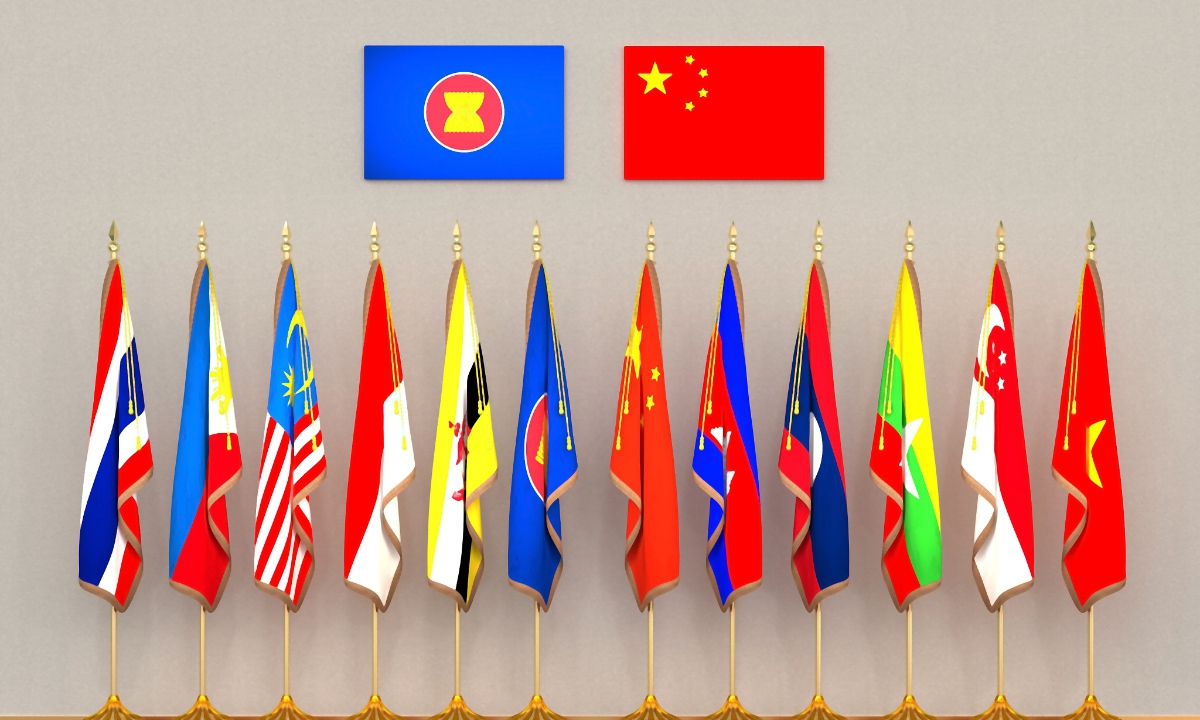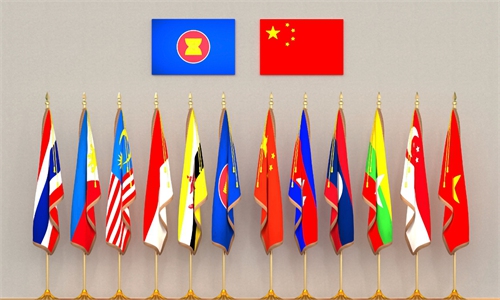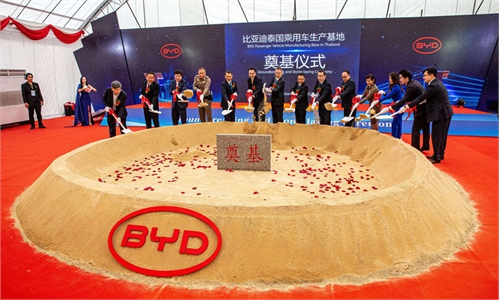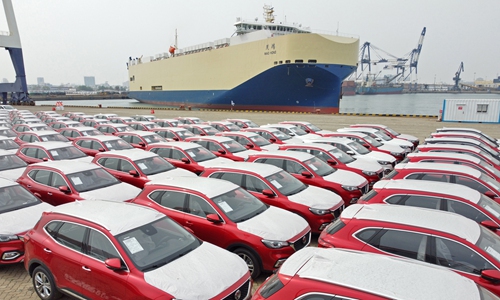ASEAN to usher in golden era of economic prosperity in closer partnership with China

China ASEAN Photo:VCG
During the past three decades, China-ASEAN partnership has witnessed sound and steady growth. Despite global geopolitical headwinds, the two sides have safeguarded regional stability and tranquility, and always supported each other's economic growth by establishing the sustained solid path of win-win cooperation.ASEAN member states have a combined population of 670 million and a gross GDP of $3.7 trillion. As a dynamic economic bloc, its annual economic growth rate is now higher than that of the US, Japan and the EU. As a result, tens of millions of people in ASEAN are becoming increasingly better-off each day.
As to the "China threat" theory that the US and its allies have been spreading, the strong relationship ASEAN and China have built over the past many years shows that the ASEAN members are always against Washington politicians' "divisive" strategy.
China and ASEAN countries have pulled together with solidarity in this trying time in the world, and the China-ASEAN relationship shows a sound momentum of all-round development. China's engagement with ASEAN is deep and varied, and it is most prominent on the economic front. China's organic economic linkages with ASEAN economies have resulted in China's economic performance having a strong impact on ASEAN's economic prospects.
Both sides have become each other's largest trading partner, with trade volume in 2022 almost topping $1 trillion, up 11.2 percent year-on-year and more than double the volume a decade ago. China is also one of the largest sources of foreign direct investment in ASEAN.
The success of ASEAN lies in its establishment of a multi-tiered and effectively-managed architecture of regional cooperation with its dialogue partners, among which ASEAN-China relations have long been one of the most vibrant and productive ties. Two decades ago, China acceded to the Treaty of Amity and Cooperation in Southeast Asia, making it the first among major countries to join the treaty. Two decades later, it is more than gratifying to see that ASEAN and China are trying their best to build on a comprehensive strategic partnership which is well poised to benefit us all.
Recently, some Western media outlets are pouring cold water on "ASEAN centrality" is managing regional affairs, spinning on the "declining impact of the ASEAN bloc" which is untrue and ill-intended. On the contrary, China has always supported the central and indispensable role of ASEAN to lead the discussion of all regional issues and help resolve all regional disputes and concerns.
As a matter of fact, due to its centrality in the Asia-Pacific economy, ASEAN is carving its space on the global stage too. For instance, in November 2020, China, Japan, South Korea, Australia and New Zealand joined the 10 ASEAN member nations to form the Regional Comprehensive Economic Partnership (RCEP), the world's largest free trade zone to date. The RCEP covers one-third of the world's population and accounts for 30 percent of global GDP. Thanks to the RCEP, about 65 percent of the goods traded among the 15 members are tariff-free, and in about 20 years 90 percent of them will carry zero tariffs. This has facilitated the unhindered flow of raw materials and finished goods across the whole region.
The Belt and Road Initiative has made many remarkable achievements. First, Belt and Road projects have facilitated economic growth and social development in many countries. Railways, roads and ports have improved transportation, and form the backbone of growth, for they connect cities with towns and rural areas, even remote villages, expediting the movement of products, including agricultural produce, and thus enlarge markets, reduce unemployment and promote education, especially in the countryside.
Second, Belt and Road projects have helped expand many countries' foreign trade thanks to the construction and improvement of ports, airports and highways. This is most evident in countries such as Laos, Cambodia, Myanmar, Malaysia and Indonesia. Such projects have also helped ASEAN to become China's largest trading partner.
During the last ASEAN Summit and Asia-Pacific regional leaders' meetings held in Indonesia, China and ASEAN signed a series of documents that will consolidate economic partnership and cooperation between the two giant economies, with the centerpiece being the upgrading of the ASEAN-China free trade agreement to version 3.0, covering new cooperation areas including digital economy, green economy and stronger supply chain. Indonesian President Joko Widodo, the meeting chair, emphasized the need to realize "concrete cooperation that is mutually beneficial" to both Southeast Asia and China.
In a sense, the central role of ASEAN in managing regional matters and addressing common concerns is not diminished or marginalized, as claimed by the Western media. And, China will always act as a strong force to back up ASEAN, politically and economically.
China's Politburo member and Foreign Minister Wang Yi outlined six diplomatic tasks for the country in 2023. Among them, Wang stressed that China "will stay committed to the principle of amity, sincerity, mutual benefit and inclusiveness, and the policy of forging friendship and partnership in our neighborhood, and deepen friendship, mutual trust and convergence of interests with our neighbors."
With regard to geographical proximity and economic interdependence, ASEAN is the top priority in China's neighborhood diplomacy. As long as the world's geopolitical unilateralism and trade protectionism continue, global demand is likely to remain subdued which will weigh heavily on global economic recovery.
Meanwhile, the world is currently encountering changes unseen in a century, and once again stands at a historical crossroads. On the one hand, the new round of technological revolution and industrial transformation is gaining momentum, and, the aspiration for win-win cooperation among the economies has grown even stronger.
Despite the complexities and volatilities in the global stage, ASEAN has successfully managed to maintain peace and stability in the region, sustain the good momentum of growth, and make remarkable economic and social achievements. Now ASEAN stands out as one of the most dynamic regions in the world, leading the post-pandemic recovery of the global economy. The GDP growth rate of ASEAN in 2022 was an impressive 5.2 percent, one of the highest among all major economies and economic groupings.
The success of ASEAN lies in its right choice of progress over regression, cooperation over confrontation, and openness over isolation. The success of ASEAN also lies in its adherence to solidarity and independence, in its cherishing of peace and development, in its respect for cultures and traditions of various members, and in its drawing on wisdom of Asian civilizations.
By the end of July this year, cumulative two-way investment had surpassed $380 billion, with China setting up more than 6,500 enterprises with direct investment in ASEAN member states. Against the backdrop of a bleak global economic rebound, Asia, especially East and Southeast Asia have become bright spots.
Moreover, the sharp, geopolitically-induced downturn in semiconductors may be bottoming out. And Huawei's impressive 5G Mate 60 Pro suggests China is moving toward self-sufficiency in high-tech much faster than expected.
As Chinese Premier Li Qiang said recently in Indonesia --"As long as we both keep to the right path, no matter what storm may come, China-ASEAN cooperation will be as firm as ever and press ahead against all odds."
The author is an editor with the Global Times. bizopinion@globaltimes.com.cn



